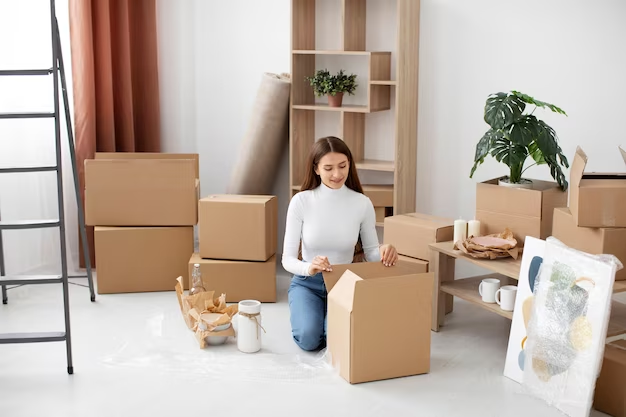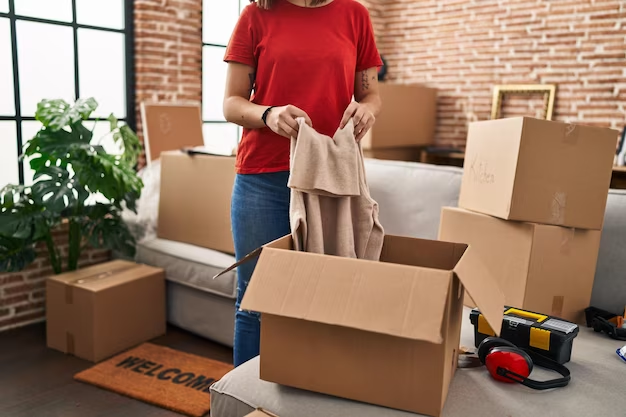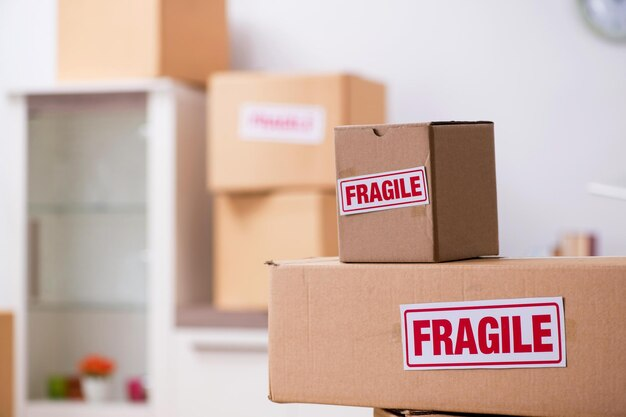Packing a 2 bedroom apartment can be a daunting task, but with the right approach, it can be efficiently managed. The question, “how long does it take to pack a 2-bedroom apartment,” is common among those preparing for a move. The answer varies depending on several factors. This article will delve into what affects the packing timeline and provide practical tips to streamline the process.
Understanding the Timeline: Factors Affecting Your Packing Schedule

When considering how long it takes to pack a 2 bedroom apartment, several variables come into play:
- Amount of belongings: More items mean more packing time.
- Packing pace: Faster packers will complete the task quicker.
- Help available: More hands make lighter work.
- Organization level: Good preparation can speed up the process.
| Activity | Time Estimate |
| Sorting and Decluttering | 1-2 days |
| Packing Non-Essentials | 2-3 days |
| Packing Essentials | 1 day |
| Miscellaneous Tasks | 1-2 days |
| Total | 5-8 days |
Kickstarting the Process: Sorting and Decluttering
Before you start packing, sort and declutter your belongings. This can significantly reduce the time needed to pack a 2 bedroom apartment.
Sorting Items by Category
One of the most effective ways to start the sorting and decluttering process is by categorizing your belongings. This method helps you identify what items you have and allows for a systematic approach to decluttering. Here’s a breakdown of common categories you can use:
| Category | Example Items |
| Clothes | Clothing, shoes, accessories |
| Books | Books, magazines, reading materials |
| Kitchenware | Utensils, cookware, appliances |
| Electronics | Gadgets, cables, old devices |
| Decorations | Artwork, home decor, knick-knacks |
| Furniture | Chairs, tables, cabinets |
| Miscellaneous | Miscellaneous items that don’t fit into specific categories |
Creating a list like this can help you stay organized throughout the decluttering process. It’s essential to tackle one category at a time, which prevents feeling overwhelmed and allows you to focus your attention on specific types of items.
Donating or Selling Items
Once you’ve sorted items into categories, it’s time to make decisions about what to do with them. The goal is to reduce clutter and only keep items that are useful or hold sentimental value. Here are some options:
- Donate: Consider donating gently used items that you no longer need but are still in good condition. Organizations like Goodwill, Salvation Army, and local charities often welcome donations of clothing, books, and household goods. Make sure to research donation centers in your area and find out their specific donation requirements.
- Sell: If you have valuable items that you no longer want, selling them can be a great way to make some extra money. You can use online platforms like eBay, Craigslist, or Facebook Marketplace to list items for sale. Be sure to include clear photos and accurate descriptions to attract potential buyers.
- Recycle or Discard: Items that are broken, damaged, or no longer usable should be recycled or disposed of properly. Check your local recycling guidelines for specific instructions on recycling various materials like electronics, cardboard, and plastics. For hazardous items like old batteries or chemicals, find out how to dispose of them safely through your local waste disposal program.
Benefits of Sorting and Decluttering
Sorting and decluttering may seem like a time-consuming task, but it offers numerous benefits:
- Saves Time: When you pack only what you need, the actual packing process becomes quicker and more efficient.
- Saves Space: Clearing out items you no longer need frees up valuable storage space in your home.
- Reduces Stress: A clutter-free environment can reduce stress and improve your overall well-being.
- Saves Money: Selling items you no longer want can generate extra income, and not buying unnecessary items in the future can save you money.
- Helps Others: Donating gently used items can benefit those in need and contribute to a sense of social responsibility.
Packing Non-Essentials: Starting with the Least Used Items

Begin with items you won’t need until after the move. This includes:
Identifying Non-Essentials
To start packing non-essential items, it’s crucial to identify what falls into this category. Non-essentials are items that you can live without for a while and won’t need immediately upon arriving at your new location. Here are some common examples:
| Non-Essential Category | Examples |
| Out-of-Season Clothes | Winter clothing during summer or vice versa |
| Books and Decorative Items | Novels, coffee table books, decorative pieces |
| Extra Bedding and Towels | Spare sheets, blankets, additional towels |
| Specialty Kitchen Items | Appliances or tools used infrequently |
Packing Strategy
Once you’ve identified your non-essential items, follow these steps to efficiently pack them:
- Gather Supplies: Before you start packing, make sure you have all the necessary supplies on hand. This includes sturdy boxes, packing paper, bubble wrap, packing tape, and markers for labeling.
- Sort by Category: Just as you did during the initial sorting and decluttering phase, sort your non-essential items by category. This helps you stay organized and makes it easier to find specific items when you unpack.
- Pack Room by Room: Approach packing one room at a time. This allows you to maintain a clear organization and ensures that items from the same room end up in the same boxes. Label each box with the room it belongs to.
- Wrap Fragile Items: For delicate or breakable items such as decorative pieces, books with sentimental value, or specialty kitchen tools, use bubble wrap or packing paper to protect them from damage during transit.
- Maximize Space: Try to maximize space in your boxes while keeping them manageable to lift. Fill gaps with packing paper or clothing to prevent items from shifting during the move.
- Label Clearly: Label each box with its contents and room destination. Use a numbering system or color-coding if it helps you stay organized.
- Create an Inventory: Consider creating an inventory list that details what’s in each box. This can be especially helpful if you need to locate specific items quickly after the move.
Benefits of Packing Non-Essentials First
Packing non-essential items first offers several advantages:
- Minimizes Disruption: You can continue your daily routine with ease as essential items remain accessible.
- Efficient Unpacking: When you arrive at your new location, you can prioritize unpacking essential items without being overwhelmed by non-essentials.
- Reduces Stress: Knowing that your essential items are readily available can alleviate the stress associated with moving.
- Prevents Overpacking: Focusing on non-essentials initially helps ensure that you don’t overpack, making the move more manageable.
- Prioritizes Safety: Fragile or valuable items receive extra care and attention when packed separately.
Essential Items: Packing with Strategy
As you get closer to moving day, focus on essentials. This includes:
Identifying Essential Items
Essential items are those you rely on daily or need urgently upon reaching your destination. To help you identify these items, here’s a breakdown of categories:
| Essential Category | Examples |
| Daily Wear and Toiletries | Clothing for the next few days, personal care products, medications |
| Basic Kitchenware | Utensils, plates, pots, pans, and essential cooking tools |
| Important Documents and Electronics | Identification documents, passports, laptops, chargers, and other electronics |
| First-Night Essentials | Bedding, a change of clothes, and items for your immediate comfort |
Packing Strategy
Now, let’s explore an efficient strategy for packing your essential items:
- Designate an Essentials Box: Designate a sturdy box or suitcase specifically for your essential items. This box should be easily accessible during your move, so choose one that stands out and label it clearly as “Essentials” or “First Night.”
- Pack Daily Wear: Select enough clothing for the next few days, considering weather conditions and activities. Fold or roll them neatly and place them in the essentials box.
- Toiletries and Personal Care: Gather your toiletries, personal care products, and any medications you need. Pack these items securely in a toiletry bag or container, ensuring they won’t leak during transit.
- Basic Kitchenware: Include essential kitchen items like utensils, plates, bowls, pots, pans, and basic cooking tools. If space allows, you can also pack some non-perishable food items, such as instant coffee, tea, or snacks.
- Important Documents and Electronics: Safeguard important documents like identification, passports, birth certificates, and any valuable electronic devices such as laptops, tablets, or smartphones. Keep chargers and necessary cables with them.
- Bedding and Comfort Items: Pack bedding for the first night, including sheets, blankets, and pillows. Include a change of clothes and any items that will provide immediate comfort, such as a favorite book or a cozy blanket.
- Accessories and Necessities: Don’t forget other essentials like keys, wallet, and any other items you use daily. These should also find a place in your essentials box.
- Label Clearly: Label the essentials box prominently with your name and destination address. This will help ensure it doesn’t get mixed up with other items during the move.
Benefits of Packing Essentials Strategically
Packing essential items with a well-thought-out strategy offers several advantages:
- Immediate Comfort: You’ll have everything you need for your first night in your new home, ensuring a comfortable transition.
- Minimized Stress: Knowing that your essential items are easily accessible can reduce the stress associated with moving.
- Efficient Unpacking: You can prioritize unpacking non-essential items later, allowing you to settle in gradually.
- Security: Important documents and electronics are protected and within reach, minimizing the risk of loss or damage during the move.
Special Considerations: Fragile and Large Items
Packing delicate items and large furniture takes extra care and time.
Fragile Items
Fragile items, such as glassware, ceramics, and delicate decorations, require extra precautions to prevent breakage. Here are detailed steps to pack fragile items safely:
- Gather Supplies: Before you start, gather the necessary supplies, including bubble wrap, packing paper, packing tape, and sturdy boxes of appropriate sizes.
- Wrap Each Item: Wrap fragile items individually in bubble wrap or packing paper. Ensure that delicate areas are well-padded and protected.
- Choose the Right Box: Select boxes that are the right size for the fragile items. Use dividers or cardboard inserts to create compartments within the box to keep items separate and prevent them from bumping into each other.
- Label Clearly: Mark the boxes containing fragile items as “Fragile” on all sides. This alerts movers to handle them with care.
- Pack Strategically: Place heavier and sturdier items at the bottom of the box and lighter, more delicate items on top. Fill any gaps with packing paper to prevent shifting.
- Use Dish Barrels: Consider investing in specialty dish barrels, which are designed for fragile kitchen items. These containers have built-in dividers for added protection.
Large Furniture
Large furniture pieces, such as sofas, dining tables, and wardrobes, present their own set of challenges when it comes to packing. Here’s how to handle them effectively:
- Disassembly: Whenever possible, disassemble large furniture items. Remove legs, shelves, and any detachable parts. Keep all screws, bolts, and hardware in labeled plastic bags.
- Wrap and Protect: Wrap furniture pieces in moving blankets or furniture pads to prevent scratches and damage. Secure the padding with packing tape.
- Use Specialty Boxes: For electronics and valuable artwork, it’s advisable to use specialty boxes designed for their protection. These boxes typically come with extra padding and secure compartments.
- Label Components: Clearly label each component of disassembled furniture and indicate which room it belongs to in your new home. This will make reassembly easier.
- Secure Glass Surfaces: If your furniture has glass surfaces, use cardboard or foam board to protect them. Tape the protective material securely in place.
- Hire Professionals: For particularly large or valuable items, consider hiring professional movers who specialize in handling oversized furniture.
Benefits of Special Considerations
Taking the time to pack fragile and large items with care offers numerous benefits:
- Prevents Damage: Proper packing minimizes the risk of damage to delicate or valuable items.
- Saves Space: Disassembling furniture can save space in the moving truck and make transportation more efficient.
- Facilitates Reassembly: Labeling and organizing components makes reassembly at your new location more straightforward.
- Peace of Mind: Using specialty boxes and materials provides peace of mind, knowing that your valuable possessions are well-protected.
The Final Countdown: Last-Minute Packing
In the last 24 hours before the move, pack:
Remaining Toiletries and Personal Items:
During the last day before your move, it’s crucial to gather and pack all your remaining toiletries and personal items. Here’s a checklist to help you stay organized:
| Item | Checklist Status |
| Toothbrush and toothpaste | [ ] |
| Soap and shampoo | [ ] |
| Toilet paper | [ ] |
| Towels and washcloths | [ ] |
| Hairdryer and styling tools | [ ] |
| Medications and prescriptions | [ ] |
| Makeup and skincare products | [ ] |
| Contact lenses and solution | [ ] |
| Razor and shaving cream | [ ] |
| Personal hygiene products | [ ] |
| Jewelry and valuable items | [ ] |
Make sure to double-check each item on this list to ensure nothing is left behind. Pack these items securely in a separate box or bag that you can easily access when needed.
Bedding and Pillows
Taking care of your bedding and pillows is essential for a comfortable first night at your new place. Follow these steps:
- Wash and dry all bedding, including sheets, pillowcases, and blankets.
- Fold and pack your bedding into plastic bags or vacuum-sealed storage bags to keep them clean and protected during the move.
- Place pillows in large trash bags or pillowcases to prevent them from getting dirty or damaged during the move.
- Label the bags or boxes containing bedding and pillows clearly for easy identification when unpacking.
Last-Minute Kitchen Items
Your kitchen may be one of the last areas to get packed up before your move. Here’s a list of last-minute kitchen items to pack:
| Item | Checklist Status |
| Plates, bowls, and utensils | [ ] |
| Pots and pans | [ ] |
| Cooking utensils | [ ] |
| Food and snacks | [ ] |
| Dish soap and cleaning tools | [ ] |
| Small appliances (e.g., toaster, coffee maker) | [ ] |
| Trash bags | [ ] |
| Paper towels | [ ] |
| Kitchen towels and dishcloths | [ ] |
Pack these items in sturdy boxes, making sure to cushion fragile items with packing paper or bubble wrap. Label the boxes as “Kitchen – Last Minute” to easily identify them.
Ensuring Everything Is Ready for the Movers or Loading:
Before the movers arrive or you start loading your vehicle, make sure you’ve completed the following tasks:
- Double-check that all your boxes are securely sealed and labeled with their contents and the room they belong to.
- Create a clear pathway for the movers or loading process by removing any obstacles or clutter.
- Disconnect and label any appliances or electronics that you’re taking with you.
- Confirm the moving schedule with your moving company or helpers and ensure you have all necessary contact information.
Conclusion
The time it takes to pack a 2 bedroom apartment varies based on several factors. However, with good planning, efficient packing, and perhaps some help, it can generally be accomplished within 5 to 8 days. Remember, the key to a smooth packing experience is organization and starting early. With this guide, your question about “how long does it take to pack a 2 bedroom apartment” should now have a clearer answer, helping you plan your move more effectively.
FAQ
Q: How can I speed up the packing process for a 2 bedroom apartment?
A: Start early, stay organized, and declutter before packing. Enlist help from friends or family.
Q: Should I hire professional packers?
A: Consider professional help if you’re short on time or have many fragile items.
Q: How many boxes will I need to pack a 2 bedroom apartment?
A: It varies, but on average, 40-60 boxes of various sizes should suffice.
Q: What should I pack last?
A: Pack essential items and a box of first-night essentials last.
Q: How can I stay organized while packing?
A: Label boxes clearly, keep an inventory, and pack room by room.



